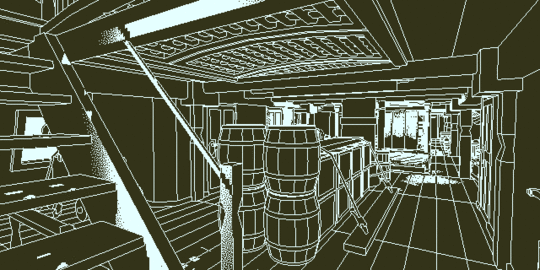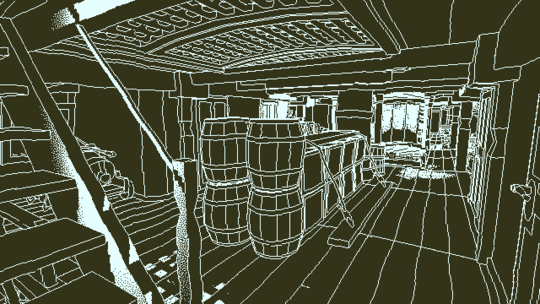Kill Screen Magazine's Blog, page 232
September 2, 2015
Lucas Pope takes us down the dark path of retouching 1-bit visuals
Return of the Obra Dinn is an upcoming Lucas Pope game with visuals so quietly gorgeous and ghost-like that only a haunting story about being lost at sea could match it. Pope, seemingly having observred the beautiful 8 to 16-bit games coming out over the past couple years, has decided to double down, using 1-bit graphics that recall early Macintosh visuals from Apple's gray, boxy glory days.
Unsurprisingly this design choice has left Pope with some unique problems throughout development. In his latest blog post on TIGSource, he takes readers through one such issue step by step. After getting the uncanny sense that the art style needed a bit of a retouch, Pope decides to add an effect that would "roughen up the low-poly straight lines everywhere." But what starts out as an innocent experiment to loosen up the style in Photoshop quickly snowballs into a litany of programming issues (imagined and real) and solutions without clear purposes. "I have been down a dark path," he warns readers. "Let me take you there." Yes, Mr. Pope, let us both go down this path of no return.

Of course, Photoshop is not equipped to handle 1-bit graphics. So just slapping on a warp effect erases some precious pixels, which may not be the biggest deal in other games but, as Pope says, "with the low-res visual style here, and just 1-bit to work with, each pixel is important. The 'wireframe' lines make lost or doubled pixels especially ugly. That leads to a rule: If we move one pixel, it shouldn't ever overlap another pixel or leave behind a hole."
"I have been down a dark path"
Inventing problems for himself for a feature he's not even sure he'll use (which, to be honest, is an activity I haven't known many developers to be partial to), Pope goes down a maze-like path to find the answer. An answer which, as it turns out, is a 2D maze in itself. "The key is that the first pixel move has to go offscreen, leaving a hole—then another pixel can move into that spot, creating another hole—etc. Wind your way around the entire screen this way and you can move each pixel one spot and never overlap or double another pixel."
But programming the 2D unicursal maze (a single path through without any branches or dead-ends) to shift each pixel one spot along the solution path isn't enough either. Scaling and adding a sine wave to the track offsets "would mean shifting the white track by 0 spots, the green track by 1, the cyan by 0, the purple by -1 and the blue track by 0, roughly." Finally, Pope appears satisfied with the effect. "There's a nice warping which definitely makes it feel more ropey than straight low-poly shapes." But ultimately, he decides, it's a bit too distracting. "Maybe it'll only be applied in the flashbacks. Maybe not. No surprise then that this rabbit hole has only dirt at the end."
Despite the uncertainty of the effect in the actual game, Pope demonstrates the benefits of curious experiments such as these during development. He transforms one of the failed wobble effects which proved too high-frequency into a focus-blur effect. By scaling between low and high-frequency mazes based on world distance from a hand-placed focal point, he creates a depth of field effect that might be perfect to "highlight the killer/killed in each flashback." Since Obra Dinn casts the player as the insurance adjuster who must unravel all that happened on the mysterious voyage, the distinction could help immensely. "Or not," Pope concludes. "After all this work I'm still not sure where or if it'll end up in the game. I really just wanted an excuse to post those maze-solving animated gifs."
Well, we'll leave you to it Lucas Pope, as long as we keep getting more tantalizing glimpses at The Return of Obra Dinn like these.

Does Mario have a penis?
A philosophical enquiry into the existence of Mario’s penis.
Navigate a Queer Zine Fair as a trans woman
In game designer Morgan Sea’s Zine Fair Lady, players navigate a queer zine fair through the eyes of a transgender woman. Though such spaces often ostensibly aim to be inclusive toward people of all sexual orientations and genders, in practice, organizers and attendees focus most on the most well-understood members of the queer community—cisgender gays and lesbians—while invalidating the identities of others.
Zine Fair Lady comes with a content warning that reads “Transmisogyny, nudity, & sex talk”; limited interactions give players some insights about the small ways individuals are marginalized even in purportedly accepting spaces. In one instance, the player character is regarded as a boy dressing up as a girl rather than as a woman; in another, she comes across a display of dildos she’s told are “for lesbians” despite that she, a lesbian, cannot physically use any of them.

While the game nearly celebrates getting misgendered only twice, that this occurs in a queer space speaks volumes as to what this character must encounter on an average day. If nothing else, Zine Fair Lady demonstrates the care with which she must choose to navigate everyday situations—the options to be more passive or more aggressive in asserting her identity both exist, but there’s social fallout regardless. In the game, as in real life, while she has the option of loudly proclaiming who she is and standing up for herself, there’s only so much confrontation she—or anyone else—can reasonably handle, and more than a few cases where keeping quiet is safer.
You can play Zine Fair Lady in your browser.
The cultural origins of the Mushroom Kingdom
Mario’s mythological background is a tribute to Miyamoto’s creativity.
September 1, 2015
Painters Guild lets you play with history to discover how the Mona Lisa came to be
Even people who don't give a shit about art are aware of the masterpieces of the Italian Renaissance. If you think you're an exception then let me destroy that notion for you. Heard of the Mona Lisa? Statue of David? How about The Creation of Adam? If you have (and, yes, you definitely have) then you are one of us.
But what of it? We all know about these pieces of art, but many people probably don't know why they're so famed, nor do they care that much to find out either. For the majority of people, the stories and legacy of these paintings and sculptures is the concern of someone else. And it's in this widespread attitude that Lucas Molina finds a vocation. He is both a videogame creator and history teacher. And so, naturally, he has combined the two for his latest project, which he calls Painters Guild.
my Da Vinci got into a bar brawl
He did this because, while he is a teacher, Molina is also an introvert. "I enjoy planning classes and finding ways to explain history to people more than I enjoy speaking to them," he explained. And so, by making Painters Guild, Molina was able to, as he put it, focus on the planning without having to worry about the people. "I really want to teach history," Molina added, "and games are an efficient way to reach the world—maybe more so than classes."
At its most basic, the idea in Painters Guild is to manage an artist's guild in 15th century Italy. You have to recruit apprentices, deliver paintings for your patrons on time, expand your guild's building spatially and decoratively, and can even train masters such as Leonardo Da Vinci. But what may be surprising to the uninitiated is that, despite being about art, Painters Guild doesn't teach you much about the craft itself. Instead, it is concerned almost entirely with the business behind it all.
As you'll discover immediately upon playing, Molina uses the lens of a management game as a veil for his subtle history lesson. As you focus on filling up progress bars, you're interjected every now and then by a messenger who arrives at a historically appropriate time to tell you of significant events in and around Florence, Venice, and Rome. Popes die, cities are burned down, and various art trends rise and fade as you progress rapidly through the years.
"I did a lot of historical research, from classics such as Vasari's Vite and Burckhardt's Civilization of the Renaissance to more recent research," Molina said. "I tried to put historical metaphors behind every mechanic of the game, and behind the aesthetics, while Morvan made sure to base the whole soundtrack in history as well." Importantly, Molina adds that Painters Guild is not "strictly" historically accurate. It's an important note to make as, at one point, my Da Vinci got into a bar brawl and I had to bail him out of trouble (costing me 200 Florins), which isn't something that actually happened to my knowledge.
Likewise, greats of the art world that you oversee can get sick, and even if you hire a doctor to fix them up, may die from the illness. While it may seem unfair, the reason for the doctor's failure is obvious, at least, as soon as you take a moment to let the frustration subside. Medicinal practices were nowhere near as effective then as they are for us these days. Sometimes people were ill and couldn't be cured. Painters Guild doesn't tell you this directly but you pick up on it as you play inside its recreated world. Another history lesson lies in the character creation screen at the start of the game. You can choose to make your character homosexual but you are warned upon making this decision that being homosexual in 15th century Italy is punishable by death. This hasn't affected any of my characters yet but the suggestion is that you're giving the randomized events system another way of killing off your character—it's a decision that comes with a risk, but to be true to nature should probably be assigned a character at random rather than being presented as a choice.

What Painters Guild is, then, is a play with history. It's a very limited sandbox that is strictly informed by possible historical scenarios. "It tries to use the concept of verisimilitude: your game experience could have happened," reasons Molina. It's a game that teaches you about the surrounding conditions and politics that informed those painting masterpieces. Some of the ramifications of privilege that the game teaches even have some weight today. For example, in my game, Da Vinci never became the famous painter we know him to be, as I couldn't afford to pay for him to go through the necessary procedures towards that status. He never painted the Mona Lisa, instead, he died a poor man with only mediocre art to his name and was forgotten by the end of the century.
You can purchase Painters Guild on Steam. Find out more on its website.
The 100 Million Deaths of the Martyr We Call Mario
What happens to Mario when he dies?
Nina Freeman's Cibele is an awkward reflection of our collective teen soul
Expect lots of awkward laughs and online chats in Cibele
Discover the contours of your virtual identity and sexuality in Cibele
Catch an early glimpse at Nina Freeman's Cibele, an exploration of cyber life and sex.
See past the avatar and into the soul in Nina Freeman's latest game Cibele
Relive the Classic American Detective Story, now with way more animals
For a brief, glorious period in the mid-20th century, Jack Webb was the voice of every detective in America. Most famously, he was the voice—and, later, corporeal manifestation—of Sergeant Joe Friday on the ür-procedural Dragnet. Webb also provided the voice for the titular, simile-dropping lead in Pat Novak For Hire and a series of largely interchangeable policeman roles. Before franchises like Law and Order and CSI revealed the fictional investigator as being largely interchangeable—a different person can spout these clichés next year and the world will keep spinning—Jack Webb was starring in every interchangeable law enforcement show in the land.
everyone wears a trench coat
I found myself thinking about Webb while playing Investigator and the Case of the Red Herring, a delightful entry in the 33rd Ludum Dare game jam. Investigator and the Case of the Red Herring is in almost every sense a stereotypical detective story: there’s the enterprising yet fallible gumshoe, their conveniently knowledgeable friend-cum-assistant, and an actual detective who is tired of these hijinks. Everyone wears a trench coat and talks like they’ve heard one too many of these stories. They probably have. Investigator and the Case of the Red Herring would be just another episode of Pat Novak for Hire—or Garrison Keillor’s parody, Guy Noir: Private Eye—if it weren’t for one crucial detail: all the characters are animals.

This twist is fodder for a great many puns and rhymes—from the titular red herring, to a suspect named Squeal the Seal, to a medical sidekick known as the Trauma Llama. Yet it also gets at the fundamentally interchangeable nature of the American detective drama. The genre’s conventions are so well-established that you can easily turn all the characters into animals and still wind up with a traditional gumshoe story. Investigator and the Case of the Red Herring is an absurdist satire, but its brand of satire, like Burning Love and The Hotwives of Orlando, is best understood as an affectionate ode to the source material that it skewers. If Jack Webb can be every detective and every detective can be Jack Webb, it is only fitting that animals can get in on the fun.
You can play Investigator and the Case of the Red Herring for free here.
An ode to Mario Sunshine, the only true Mario world
Mario’s never been anywhere quite like Isle Delfino.
Kill Screen Magazine's Blog
- Kill Screen Magazine's profile
- 4 followers





